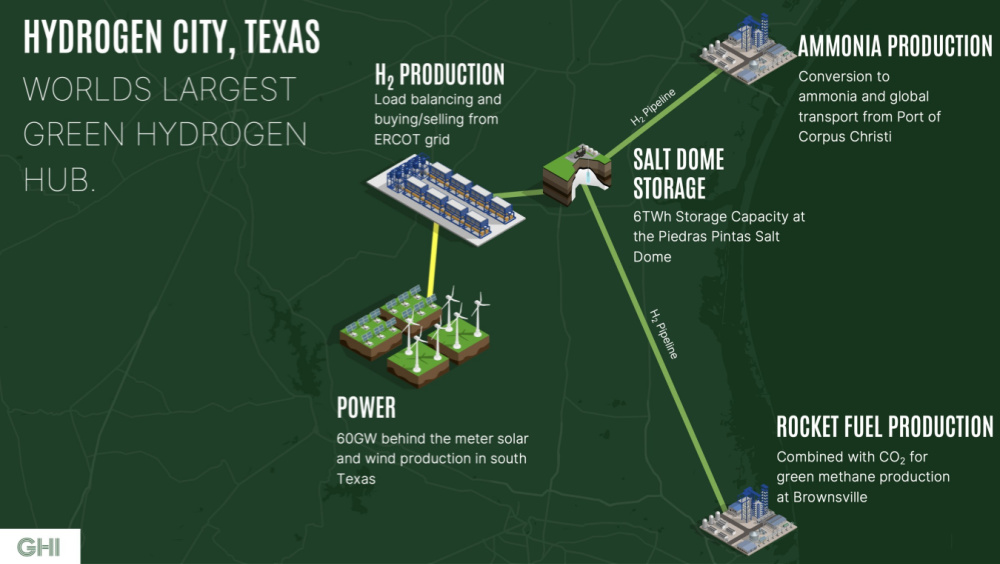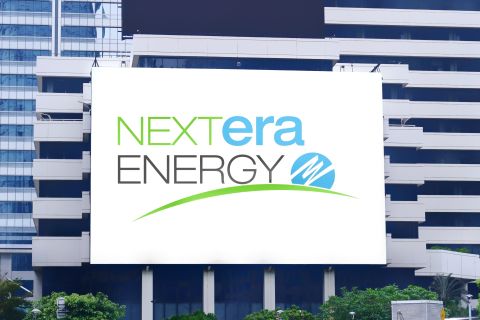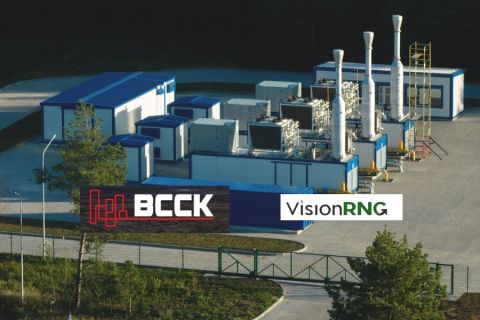Green Hydrogen International (GHI) unveiled plans on March 3 to create Hydrogen City, Texas, a green hydrogen production and storage hub in South Texas which the company claims will be the world’s largest.
“Hydrogen City is a massive, world-class undertaking that will put Texas on the map as a leading green hydrogen producer,” GHI Founder and CEO Brian Maxwell commented in a company release.
Based in Austin, Texas, GHI is a green hydrogen development company with a global pipeline of large-scale projects located near low-cost renewable energy, salt storage and large markets.
“Texas has been the world leader in energy innovation for over 100 years and this project is intended to cement that leadership for the next century and beyond,” added Maxwell, a long-time renewable energy entrepreneur who founded GHI in 2019.
Hydrogen City, Texas will be an integrated green hydrogen production, storage, and transport hub growing to 60 gigawatts (GW) in size and producing over 2.5 billion kilograms of green hydrogen per year.
The project will be built in phases with the first phase expected to commence operations in 2026, consisting of 2 GW of production and two storage caverns at the Piedras Pintas salt dome located in Duval County, Texas.
Pipelines will deliver the green hydrogen to Corpus Christi and Brownsville where it will be turned into green ammonia, sustainable aviation fuel and other products, or delivered by pipeline directly to hydrogen power plants and other users around the state.
The project will be powered by 60 GW of behind-the-meter solar and wind power with additional renewable energy drawn from the ERCOT grid during periods of low prices. Eventually, over 50 caverns can be created at the Piedras Pintas salt dome, providing up to 6 terawatt-hours (TWh) of energy storage and turning the dome into a major green hydrogen storage hub, similar to the role Henry Hub plays in the natural gas market, according to the company release.
The plans for Hydrogen City are large enough that eventually the project could supply multiple types of customers, Maxwell added.
“We see Hydrogen City becoming one of the largest H2 production centers in the world, supplying many different customers with 100% clean H2 fuel,” he said.
The GHI release noted the market growth for hydrogen will be enormous citing an unnamed top global consulting firm. A recent sector report estimates annual global sales for hydrogen and related technology at $2.5 trillion per year by 2050, the release said.
Andy Steinhubl, a former McKinsey Senior Partner and GHI board member, further commented: “Hydrogen City is a project perfectly positioned near low-cost renewable resources, plenty of available land, salt domes, and proximity to the large energy port of Corpus Christi. It will be a world cost leader and position GHI to take advantage of the growing demand for green hydrogen.”
Australian-based renewable energy developer Energy Estate is assisting GHI on the development of Hydrogen City.
GHI also noted negotiations are ongoing with respect to end-use options for GHI produced green hydrogen. These options include:
- Green ammonia for export markets: GHI is exploring the opportunity to export green ammonia to Asia. Japan’s Ministry of Economy, Trade and Industry (METI) plans to add 30 million tonnes per year of renewable ammonia to the country’s fuel mix by 2050. “Japanese and Korean companies are interesting partners for us in this project given their countries desire to shift to green ammonia,” Maxwell said.
- Green ammonia for the fertilizer market: Higher natural gas prices has led to skyrocketing fertilizer costs for farmers. Fertilizer produced from green hydrogen can help remove unexpected price volatility.
- Sustainable aviation fuel: GHI is in discussions with potential off takers of green hydrogen as a feedstock for sustainable aviation fuel (SAF). GHI believes Corpus Christi is well placed to become a major SAF production hub.
- Sustainable Rocket Fuel: The company is looking at combining hydrogen with CO₂ at the Port of Brownsville to create a green methane rocket fuel for launch operations in South Texas.
- Fuel switching power plants: H2 can also be used as a natural gas substitute at power plants. Over 4 GW of new gas power plants have been proposed in the US that can burn a combination of hydrogen and natural gas.

Recommended Reading
Solar Sector Awaits Feds’ Next Move on Tariffs
2024-04-25 - A group of solar manufacturers want the U.S. to impose tariffs to ensure panels and modules imported from four Southeast Asian countries are priced at fair market value.
Solar Panel Tariff, AD/CVD Speculation No Concern for NextEra
2024-04-24 - NextEra Energy CEO John Ketchum addressed speculation regarding solar panel tariffs and antidumping and countervailing duties on its latest earnings call.
NextEra Energy Dials Up Solar as Power Demand Grows
2024-04-23 - NextEra’s renewable energy arm added about 2,765 megawatts to its backlog in first-quarter 2024, marking its second-best quarter for renewables — and the best for solar and storage origination.
BCCK, Vision RNG Enter Clean Energy Partnership
2024-04-23 - BCCK will deliver two of its NiTech Single Tower Nitrogen Rejection Units (NRU) and amine systems to Vision RNG’s landfill gas processing sites in Seneca and Perry counties, Ohio.
Clean Energy Begins Operations at South Dakota RNG Facility
2024-04-23 - Clean Energy Fuels’ $26 million South Dakota RNG facility will supply fuel to commercial users such as UPS and Amazon.





